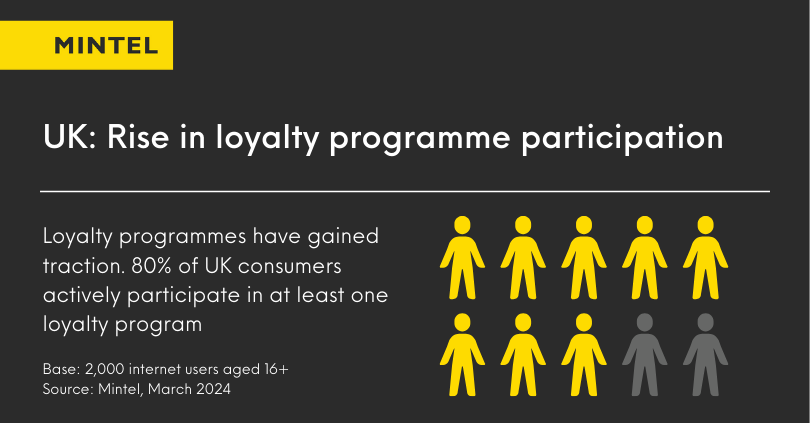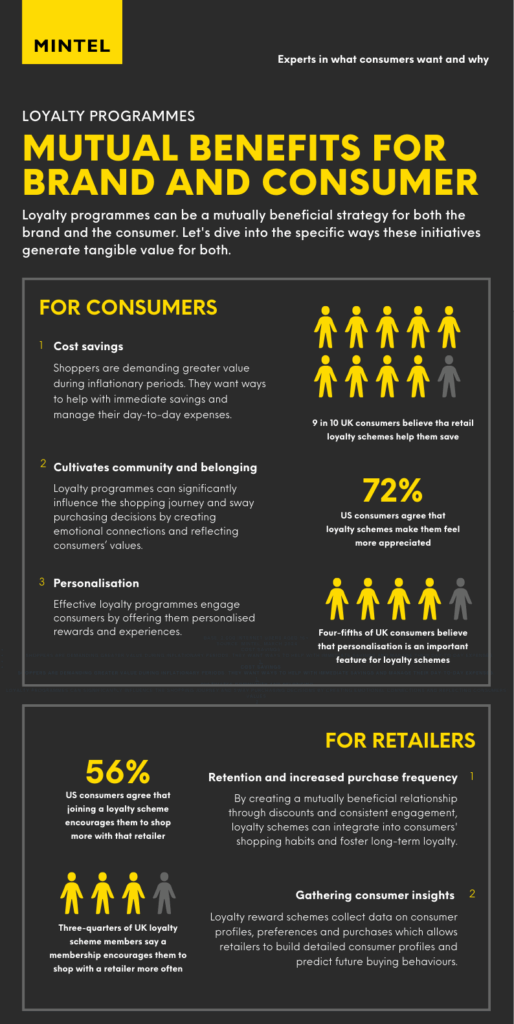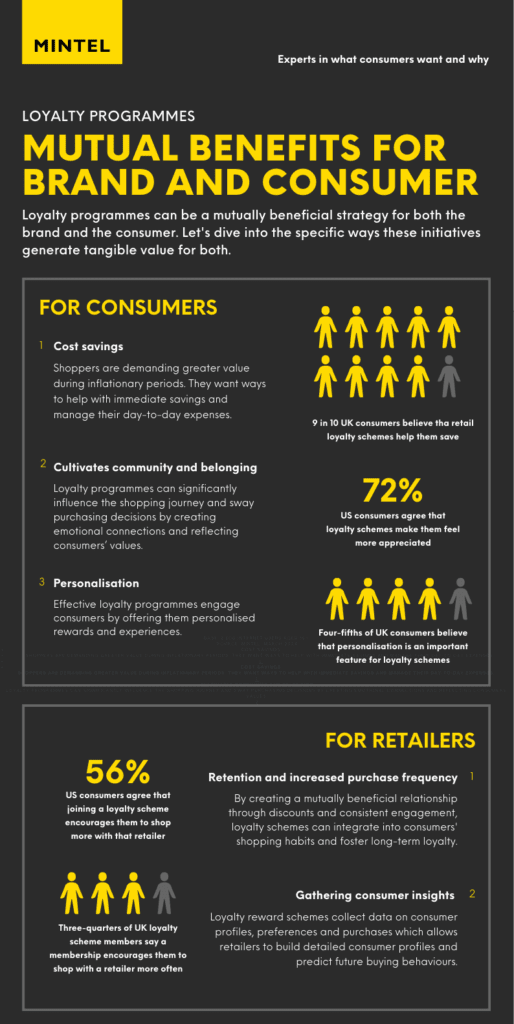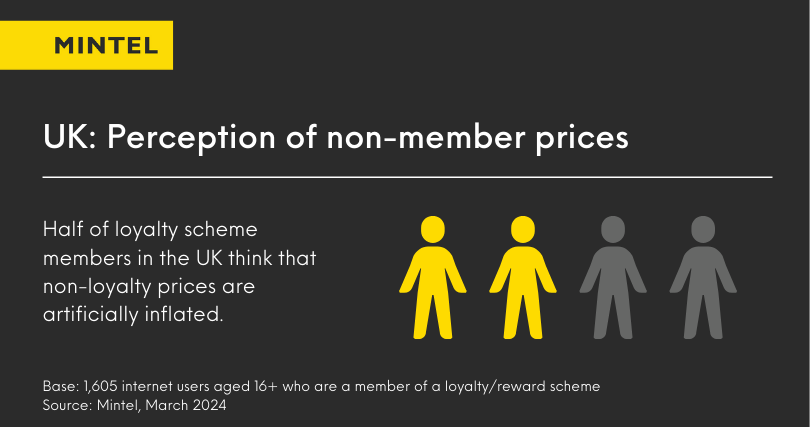Inflation is forcing consumers and businesses alike to rethink their priorities. For shoppers, this often means cutting unnecessary spending, trading down, or seeking out better value. For retailers, it means finding innovative ways to retain customers, drive sales, and maintain loyalty in an increasingly competitive environment.
Enter retail loyalty programmes: a powerful tool that’s being reimagined amid economic uncertainty.
Beyond offering traditional perks like discounts and points, modern loyalty programmes are evolving into complex drivers of consumer engagement, emotional connection, and long-term retention.
This blog explores how retail brands are utilising loyalty programmes to deliver value during times of inflation. From consumer insights to practical applications, we’ll uncover why this trend is gaining traction and how brands are using this initiative to build a stronger relationship with their consumers.
Loyalty Programmes Overview in Key Regions
Loyalty programmes have gained significant popularity globally, with notable developments in the UK, US, Ireland, and Germany. Each of these regions demonstrates unique trends and adoption patterns, reflecting diverse consumer preferences and economic conditions.
The UK has seen a sharp rise in loyalty programme participation, with 80% of consumers actively engaging in at least one loyalty programme. Retail and grocery sectors dominate this space, with brands like Tesco Clubcard and Sainsbury’s Nectar leading the way. The growth of retail memberships has been reinforced by most leading schemes now adopting membership pricing, tapping into the demand for more instant gratification in rewards from such schemes.

A similar story reveals itself in the US, with over 8 in 10 consumers believing loyalty programmes make them feel valued as a customer. Major players like Walmart+ and Amazon Prime have set benchmarks for customer-centric programme design, focusing on savings, convenience and flexibility, which drives competition among retailers.
Ireland’s loyalty programme market, while smaller in scale, mirrors the trends seen in its neighbouring UK. Premium subscription models like Amazon Prime and ASOS Premier are gaining traction. These memberships encourage more frequent online shopping by offering financial incentives, and also help build a sense of community among consumers
In Germany, loyalty programmes and paid subscriptions are popular, particularly among Millennials, who prefer immediate offers and benefits. Retailers are encouraged to align loyalty rewards with younger shoppers’ interests, such as ethical and sustainable shopping values, and to incorporate engaging elements like gamification.
By understanding these regional nuances, businesses can craft strategies that align with local consumer expectations while driving meaningful engagement and long-term loyalty.
Types of Retail Loyalty Programmes
Loyalty programmes come in various formats, each tailored to deliver specific incentives to consumers, all the while aligning with retailers’ business goals. Here are the main types:
- Points-based system
Customers earn points for every purchase, redeemable for discounts or rewards. An example is Tesco Clubcard, which allows members to collect points and convert them into vouchers, providing a mixture of instant and long-term benefits.
- Tiered programmes
Members can unlock increasing benefits as they spend more, fostering aspirational engagement. One brand utilising this method is Sephora’s Beauty Insider, which uses three tiers to provide escalating perks like exclusive beauty events and free shipments.
- Paid memberships
Consumers are encouraged to pay a subscription fee in exchange for premium benefits, such as free delivery or member-only pricing. Walmart+ uses this scheme to offer free shipping, fuel discounts, and access to Paramount+ streaming for a monthly fee.
- Value-based programmes
This loyalty programme focuses on gaining and aligning rewards with customers’ values, such as donating points to causes or receiving sustainable product discounts. The French retailer Decathlon allows users to accumulate points by engaging in outdoor activities and sharing activity routes through its app.
Mutual Benefits for Brand and Consumer


Challenges Retailers Face with Loyalty Programmes
Loyalty programmes hold immense potential for retailers to nurture customer relationships and drive repeat business. However, they also present significant challenges that must be addressed to ensure success. By understanding these hurdles and utilising Mintel’s actionable insights, retailers can create retail loyalty programmes that truly stand out and deliver long-term value.
Over-saturation and lack of differentiation
With many retailers adopting similar loyalty schemes, there is a risk that these programmes become indistinguishable. This over-saturation has left 45% of UK consumers feeling that loyalty schemes offer similar benefits. To stand out in this competitive space, retailers need to innovate.
For brands, personalisation is key. Focusing on evolving their programmes to leverage customer data to provide added value, and considering paid retail membership options to cultivate stronger loyalty through increased consumer commitment, are also crucial avenues for differentiation.
Complexity and consufion
As loyalty programmes evolve to include more features such as tiering, challenges, and gamification, they risk becoming too complex. A third of consumers in the UK find these schemes confusing, which can deter participation and reduce the perceived value of the programmes. Simplifying programme mechanics while retaining a personalised touch is critical. Retailers should focus on creating user-friendly systems that clearly explain how customers can earn and redeem rewards. Streamlined processes, such as instant discounts or transparent points systems, can make programmes more intuitive and appealing.
Perception of inflated prices
Widespread adoption of member pricing means that their USP has eased, and there is the threat that customers will become disenchanted with the value they offer. More worrying is that half of scheme members think non-loyalty prices are artificially inflated to make member discounts appear more attractive. This perception can erode trust and diminish the credibility of loyalty programmes. To counter this issue, retailers should adopt transparent pricing strategies. Clear and honest communication about pricing and discounts can reassure consumers and foster trust.


Data security concerns
Loyalty schemes rely heavily on collecting customer data, which raises privacy concerns. Mintel’s research reveals that over half of UK loyalty programme members are concerned about how their personal data is used. This apprehension can deter customers from fully engaging with a loyalty programme.
To address these concerns, retailers must implement robust data protection measures and maintain transparent policies on data usage. Clearly communicating how customer data is collected, stored, and used will help build trust and encourage participation. Additionally, offering customers control over their data, such as opting out or managing preferences, can further enhance confidence in the retail loyalty programme.
Innovations Shaping the Future of Loyalty Programmes
To stay ahead, retailers are exploring innovative ways to engage new customers and provide value to returning customers.
- Gamification
Gamification is transforming retail membership programmes by adding an element of fun and engagement to customer loyalty. Features like Tesco’s AI-powered Clubcard Challenges and Selfridges Unlocked show how gamified loyalty schemes can encourage frequent interactions and reward loyal behaviours. Selfridges Unlocked integrates gamified elements like collecting digital keys, encouraging members to earn points through various activities such as shopping and dining, enabling them to unlock perks like free shipping and access to exclusive launches.
By incorporating regular challenges and creating dynamic rewards, gamification boosts consumer engagement and sustained participation, addressing one of the drawbacks of an instant gratification culture, where consumers often disengage quickly.
- Personalisation
Effective loyalty programmes engage consumers by offering personalised rewards and experiences. This crucial customisation helps maintain consumer interest and loyalty, as it aligns with their individual preferences and needs. This desire for tailored experiences is echoed by almost four-fifths of consumers who believe that personalisation is an important aspect of loyalty and reward schemes. This reflects a growing expectation for schemes that truly cater to individual preferences and shopping habits. Personalisation is seen as a way to enhance the value and relevance of these programmes, moving beyond generic discounts to offer tailored rewards and experiences that resonate more deeply with members.
The demand for personalisation in loyalty programmes is consistent across various demographic groups, highlighting a unified desire for more customised interactions. Retailers are increasingly leveraging AI and data analytics to meet these expectations, aiming to transform loyalty schemes into more personal shopping companions rather than solely discount vehicles. However, achieving this level of personalisation requires building trust with consumers, particularly concerning data security and transparency.
- Rewarding behaviour with exclusivity
For example, programmes like H&M Club and Kith’s loyalty initiative highlight how tiering is becoming a key feature in loyalty strategies. Kith’s scheme is based around three tiers, with consumers progressing through tiers based on points accumulation. Points can be gained by purchasing, but also through completing challenges and checking into stores and Kith events.
Beyond boosting the frequency of purchases, tiering is also effective in shaping desired consumer behaviours. Retailers can reward actions like in-store returns or buying own-label products by offering higher points or access to premium tiers. This approach not only trains customers to adopt behaviours that align with the retailer’s goals, but also ensures shoppers feel valued and rewarded for their loyalty.
- Sustainability rewards
There is a growing number of loyalty programmes that reward consumers for eco-friendly choices. Decathlon understands its consumers’ passion for sport and sustainability, and has designed its multifaceted retail loyalty programme to go beyond simple discounts. Their scheme Decat’Club actively rewards customers for engaging in activities that promote both sports and sustainability. This innovative approach demonstrates Decathlon’s understanding of its community’s commitment to healthy living and environmental responsibility, making their loyalty programme a true reflection of their customers’ values and a powerful driver of engagement.
- Offering cashback
JD Sports is actively encouraging repeat purchases and loyalty among its key demographic of young consumers through its Status app, which provides cashback on in-store purchases. The app offers members 10% cashback on their first purchase and 1% cashback on subsequent purchases, to be spent with the sports retailer. This cashback incentive not only fosters consumer loyalty and drives repeat business but also boosts in-store engagement.


Deliver Value During Times of Inflation with Mintel
Retail loyalty programmes have evolved far beyond simple point systems. They now represent a strategic asset capable of improving customer retention, increasing spend, and fostering emotional connections with brands.
However, as inflation continues to pressure wallets, the bar for loyalty programme success is higher than ever. Retailers thriving in this environment are those that simplify processes, offer meaningful rewards, and leverage technology to deliver personalisation at scale.
Is your loyalty programme adapting to meet these challenges? Explore the full range of Retail Market Research on the Mintel Store to equip yourself with the latest research. Or sign up for free to Mintel Spotlight to read articles and thought leadership pieces featuring fresh insights and innovation recommendations from industry experts.
